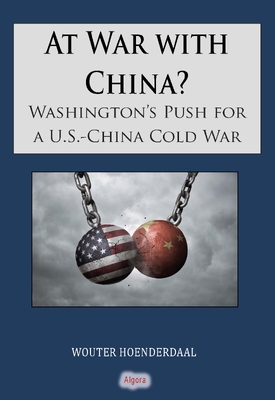
Sound Bite
Western policy toward China amounts to a "cold" war that is heating up rapidly, bringing us closer to a devastating conflict. The author examines the provocations over Taiwan and the South China Sea, economic sanctions amounting to economic warfare, and the broader challenge of competing for resources in the Global South.
The book also highlights examples from the US–Soviet contest to remind us how severely such misguided Western actions impact other countries who are not even direct participants in the conflict.
About the Author
As a data scientist working at Wageningen University & Research, Wouter Hoenderdaal uses data analysis and artificial intelligence to solve problems. He also uses these techniques to study history, geopolitics, and great power competition.
The author’s main interest is in the emerging U.S.-China Cold War, with a focus on military conflict, economic competition, and information warfare. As a Westerner, he feels a responsibility to criticize Western foreign policy, something which is lacking within the mainstream yet very much needed in times with rising tensions.
|
|
About the Book
The fact that Western leaders are largely responsible for the deterioration of relations with China is ignored by the mainstream. This book shows exactly how Western actions are adding fuel to the fire.
The author examines U.S. provocations...
The fact that Western leaders are largely responsible for the deterioration of relations with China is ignored by the mainstream. This book shows exactly how Western actions are adding fuel to the fire.
The author examines U.S. provocations over Taiwan and the South China Sea, Western economic warfare directed at China, superpower competition for resources in the Global South, and information warfare. His graphs and data help illustrate the history and context.
Various conflict scenarios are explained in detail. These include Washington’s military strategy to contain China, and so-called “democracy-building” exercises and “Color Revolutions” to overthrow governments not loyal to the West. The author also explains how economic sanctions are used to suffocate the economies of Western adversaries, and shows the role of information warfare in justifying Western aggression and mass murders, from Africa and Southeast Asia to Latin America, Iran, Iraq, Serbia and Ukraine.
The book centers on a clear presentation of key turning points in the deterioration of relations between the U.S. and Russia and then between the U.S. and China, enabling us to see how the other side would likely interpret our actions and thus how our intransigence inevitably drives us forward to more violent confrontations.
The book is written in an engaging style, for all readers with an interest in history, politics, and international affairs. Progressives, libertarians, activists, concerned citizens, and others who oppose aggressive Western foreign policy will certainly enjoy the book. It presents information not found within the mainstream, and by doing so, presents readers with new ways of understanding these very important developments.
|
In the chapters that follow, the different types of conflict between the United States and China are discussed. This includes military conflict, covert (secret) operations, economic war, and informati
In the chapters that follow, the different types of conflict between the United States and China are discussed. This includes military conflict, covert (secret) operations, economic war, and information warfare. Actions from both sides are described, but with an emphasis on how Western acts will result in escalation and war, and how, in some cases, they already are.
Chapter 1 lays out how we got there.
Chapter 2 focuses on the U.S. military approach towards China and Taiwan. An important theme is Washingtonâs attempt to surround and âcontainâ China with hundreds of military bases.
Chapter 3 dives into the realm of economic and technological warfare. The South China Sea is at the center of Chinaâs trade, which is why Beijing is busy building up military installations on a series of artificially created islands. Meanwhile, American strategists are thinking of sending in the U.S. Navy to blockade key waterways to choke off Chinaâs economic lifelines.
Chapter 4 explores the global nature of the emerging U.S.âChina Cold War. In the Global South, both the United States and China are hoping to install governments obedient and loyal to their cause. The likely outcome will be brutal civil wars.
Chapter 5. The last dimension of the brewing Cold War is information warfare, waged via elaborate media and information systems. One is state-owned, the other private; yet they produce remarkably similar news. Both sides produce and spread information that supports their governmentâs actions. In fact, Western news organizations have a long history of working together with their governments, helping to justify and support Western wars. But what would happen if you were to step outside of this media bubble? Would you see the world and the U.S.âChina Cold War differently? And will it help you to understand what is really going on?
Finally, Chapter 6 explains Washingtonâs endgame. What do U.S. officials want from China? The answer is surprisingly simple.
|
|
Pages 212
Year: 2023
BISAC: HIS037100 HISTORY / Modern / 20th Century / Cold War
BISAC: POL011000 POLITICAL SCIENCE / International Relations / General
BISAC: HIS027130 HISTORY / Wars & Conflicts / General BISAC POL062000 POLITICAL SCIENCE / Geopolitics
Soft Cover
ISBN: 978-1-62894-515-7
Price: USD 19.95
Hard Cover
ISBN: 978-1-62894-516-4
Price: USD 29.95
eBook
ISBN: 978-1-62894-517-1
Price: USD 19.95
|












